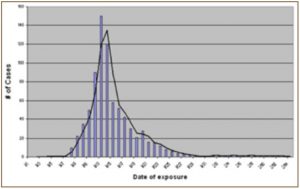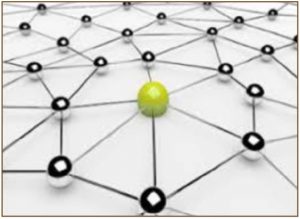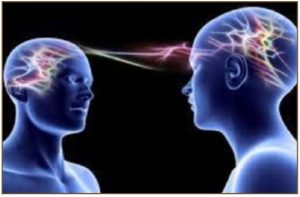Half-time of Narratives – an Epidemiological View

Part II of the series, “A Working Family Governance Needs Family Narratives”
Like emotions, narratives are contagious, thanks to our mirror neuron network. The behavioural economist Robert Shiller describes in his book ‘Narrative Economics’7, how narratives drive economic events including booms and busts – again evidence for the power of narratives. He uses methods from epidemiology to understand the contagion rates of stories as the patterns of narrative epidemics mimic disease epidemics. For an epidemic to ensue, the infection – rate must exceed the recovery rate or death rate, until the process reverses as depicted below.

We process narratives context dependent, based on our qualia and underlying beliefs. Good narratives evoke emotions and are contagious, so that an increasing number of people believe in it until the trend reverses, and the majority believe in a different, more compelling narrative. Thus, the old narrative has lost relevance and its effect on (social) decision-making!
A lasting narrative must be kept relevant for all family members, so it can remain integrated in the current mental model of the world.
Keeping the Narrative Alive – Hermeneutics
Hermeneutics is the art of understanding and making sense of our social environment by integrating information in our personal mental model of the world. We integrate something unfamiliar into our familiar way of seeing things, seeing similarities in differences and enlarge our perspective by making new connections and meaning. Every story must be redacted, guided from traditions to make these connections, which requires imagination and dialogue. The absence of it leads to attrition or fundamentalism. Panta Rhei, every generation must have the possibility to connect to the old version and up-date the narrative with their experiences they make as current generation. Thus, every narrative if it should be kept effective, must be an open book that allows for co-evolution, co- interpretation and co-integration.
Inherited Narratives

Narratives demonstrate their power as social glue also based on genetic foundations also based on genetic foundations as we inherit narratives that do not belong to us.
The structure of the genetic code for each person is fixed at conception, but the functioning of the genes (gene expression) is highly dynamic. Genes get tagged with chemical markers that suppress or accentuate gene expressions8. The reinterpretation or change in gene expression is performed by individual psycho-neurological structures in conjunction with external, contextual stimuli – such as narratives – and change patterns of thinking and feeling and hence, behaviours.
Research found evidence, that epigenetically altered gene expressions are partly passed on to following generations. Thus, our mental model of the world is created through neurally codified experience and trans-generational, epigenetically modified neural structures.
Co-Creating Narrative Governance
 There are two interdependent, recursive co-creation processes in narrative governance. The fragments of a narrative must be identified, interpreted and subsequently integrated in a comprehensive, coherent representation in the gestalt of an epistolary novel9. Historical events are not easy to reconstruct, so incomplete information must be artfully completed by inferences based on facts.
There are two interdependent, recursive co-creation processes in narrative governance. The fragments of a narrative must be identified, interpreted and subsequently integrated in a comprehensive, coherent representation in the gestalt of an epistolary novel9. Historical events are not easy to reconstruct, so incomplete information must be artfully completed by inferences based on facts.
Narrative Fragment Inventory [NFI]
The author must desk research and look for publicly available fragments of the family history before he or she conducts group- and individual interviews to elicit information about the family history from all family members across generations. Some fragments are easily accessible, others are buried deep inside their minds – some are consciously suppressed by social norms, some are unconsciously suppressed. Thus, the author should employ coaching technics to elicit information.
The Family Narrative

Based on the NFI, the author and the family artfully co-create a narrative which is more than the sum of its parts. The narrative is entertaining, provokes curiosity, suspense and surprise. To be remembered and mentally owned, it is an engaging, emotion provoking story that sets many emotional markers. Recipients are able to relate to and, identify with the protagonist e.g. the founder of the business. Recipients empathize with what h/she went through while creating the wealth.
After the family has ratified the co-created document, the narrative must be read, told and talked about by everyone in order to engram the desired psycho-neurological pathways. Ideally, the narrative is ingrained in the subconscious, as it produces meta-cognitions and guides conscious behaviours. Yet, everything must be kept open for changes driven by system evolutions.
Conclusion
Family governance creates attractors that keep systems dynamically synchronized. Due to our neurological disposition, family constitutions alone are ineffective attractors because of their limited accessibility. In contrast, narratives are easy to remember and to associate with, as they are processed in different parts of our brains. To make family governance effective and sustainable, we need to work holistically with our neurological structure, starting with family narratives to embrace the past which informs the present and guides expectations about the future. Thus, family constitutions should be embedded in the family narratives. Furthermore, narratives have more freedom degrees than family constitutions.
The combination of both creates a balanced amount of freedom degrees, is easy to remember in daily life and specific enough, when push comes to shove. Combining both is the most effective way to make business family systems resilient for current and future generations.
6. Framing Effects: Behavioural Dynamics and Neural Basis, Xiao-Tian Wang, Lilli Rao, Hongming Zheng in Neuro Economics, Springer.
7. Narrative Economics, Robert J. Shiller, Princeton University Press.
8. The Student’s Guide to Cognitive Neuroscience, 4th Edition, Jamie Ward, Routledge.
9. Like Goethe’s ‘Sorrows of Young Werther (1775) or the satiric counter-version by Friedrichs Nicolai, ‘The Joy of Young Werther’ in the same year.
From Horizons, September 2020.









